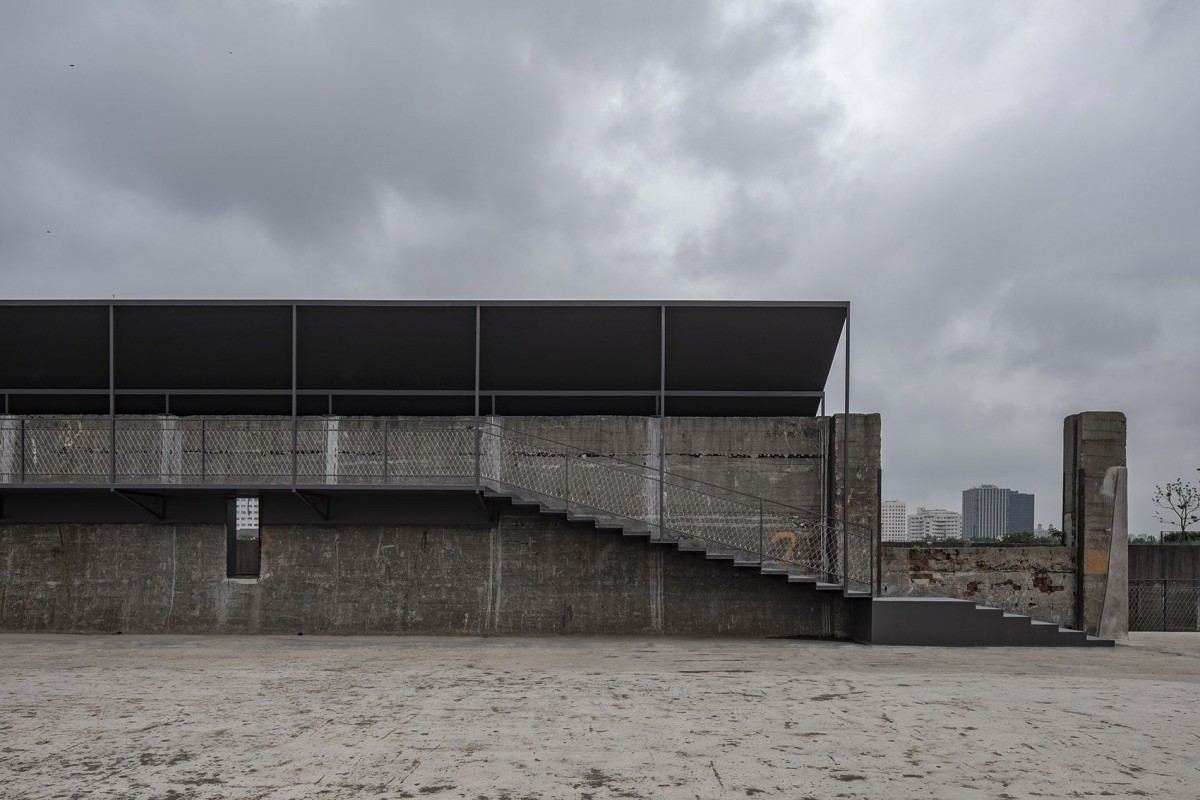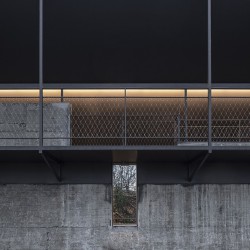Atelier Deshaus . photos: © Tian Fangfang
The site of the Riverside Passage was previously used as a coal-unloading wharf for transport connected to the old Yangpu Gas Plant. A reinforced concrete wall, which is 90 meters long and 4 meters high, was built to prevent coal from falling down into the river. After the coal wharf was deserted, this long wall became abandoned and fell into solitude. There were originally two walls on the wharf. The one along the river had been removed long ago and filled in the gap between the wharf and the flood control wall.
In the gap that is covered by dust, coal debris and concrete blocks, seeds sprout and grow into trees that accompany the long wall. It becomes a scenery specific for being like ruins. This scenery gradually vanishes in the gentrification-oriented urban regeneration in Shanghai in recent years. It is urgent to retain the characteristics of this existing scenery in the regenerated waterfront turned from industry to public open space, for this is the witness of the prosperous industrial activities in Shanghai over the past half century.
The project adopts the long concrete wall as a platform for new construction. Significance of being a solid earthwork is assigned to this wall, which also serves as a foundation for a sloping bridge connecting the flood control wall and the wharf and then traversing the wild trees, for an elevated long open corridor, as well as for a resting pavilion. A single-pitched roof is designed to demarcate the space inside and outside the wall. Faced inside the wall is a garden of solitude in between the gap of the wharf and the shore, and there is also a low corridor on the ground level. Outside the wall is a cantilevered corridor for visitors to overlook at the Huangpu River. The difference between these two corridors – one is lowered and the other is elevated – implies the changing scales in different distances and viewing sceneries.
The wharf devoid of coal-unloading is now polished into a roller rink, which makes a close spatial relationship with the cantilevered corridor in short distance. The ground, the concrete wall and the inserted structure are integrated into a new ensemble, where people might choose to linger or pass by as they wish. The former coal wharf is now turned into an urban place for flaneurs. The slender post-and-beam steel structures act as a series of finders, and they frame out the witnesses of different epochs – chimney of the old gas plant, cranes in bright colors, concrete blocks embedded in mud and washed repeatedly by tide, high-rises across the river, bridges far away – as with the movements of people.
In The Ruin, Georg Simmel suggests that, in the ruin of a building, out of “what art still lives” and returning nature, a “new whole, a characteristic unity” is produced. Thus, we could perhaps say that, in the case of the ruin, what produces an aesthetic effect is that the “same forces which give a mountain its shape through weathering, erosion, faulting, and the growth of vegetation, here do their work on old walls”. Or, we could borrow terms from ecology and say that the very ground which afforded support to the construction and design of the building, and which may have provided the materials for its construction, is now producing a fusion of ruin and landscape: “the ruin orders itself into the surrounding landscape without a break, growing together with it like tree and stone whereas a palace, a villa, or a peasant house, even when they fit perfectly into the mood of the landscape, always stem from another order of things”. For Simmel, a building that has not yet undergone the process of ruination, can “blend with… nature only as if in afterthought”. Before these “ruins” truly return to nature, we attempt to create a way to not just terminate the process but also make them into natural objects in architecture. The Riverside Passage is a garden of ruins, but more than a garden. It’s an embodied landscape.
_





























